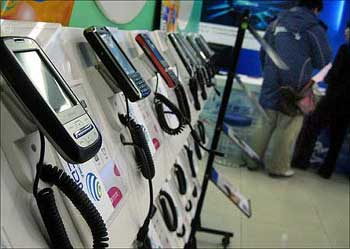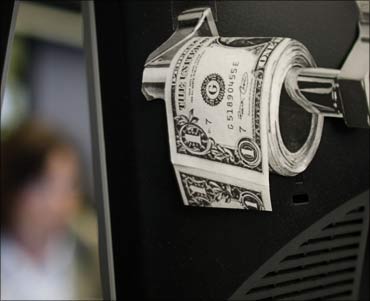
One of the several characters that embellish the great epic, Rishyashringa's story provides a perfect context to the approach of the prime minister to the 2G spectrum scam.
Son of the sage Vibhandaka, Rishyashringa was brought up by his father in perfect seclusion in higher Himalayas. As such, Rishyashringa had never come across any mortal, man or woman, except his father. His father's idea was that only if his son is brought up in complete ignorance of sensual pleasures would it be easy for him to lead the life of perfect chastity.
Thanks to his perfect penance and severe austerity, Rishyashringa, according to the epic, had acquired powers to bring rains in plenty wherever he went. As fate would have it, during a severe drought, left with no other choice, the king of Angadesh (modern Assam) used the services of his beautiful courtesans to bring him to Angadesh.
The instinctive yearning for society, especially for the opposite sex, began to work on Rishyashringa.
Please ...
The author is a Chennai-based Chartered Accountant.

According to the late C Rajagopalachari, this story brilliantly illustrates how 'virtue guarded only by ignorance is highly insecure'. If only the father had also explained life in greater detail to the son, perhaps Rishyashringa would have handled the situation much better.
Since then, in Indian folklore, Rishyashringa stands for 'virtue coupled with ignorance'. And that according to wise men is irrelevant, especially for men in power.
But that is precisely what the media managers of the prime minister want us to believe: that the prime minister of India on the whole is innocent and ignorant of the 2G scam.
There is no doubt that the prime minister is a man of great integrity. But what about the loot? Not much explanation has been given on this. What did he do to prevent the same? Not much. What did he do to dissuade such tainted persons from becoming ministers in 2009? Perhaps, nothing.
Please ...

The 2G scam is often referred to as the mother of all scams. Wait, the grandmother and great grandmother of scams are yet to explode before us.
But for now, let us reserve the grandmother and great grandmother of scams for another day and return to the mother of all scams.
By now it is a familiar story for most Indians as to how telecom licences were awarded in January 2008 at 2001 prices, violating all possible norms and with the apparent intention of favouring some.
But let me explain it in brief, nonetheless. It is now well known that on September 24, 2007, a press note was issued by the Department of Telecom stating that the applications for the issue of licences would be accepted by the October 1, 2007 only.
Till then 167 applications were received. But in the next 8 days, 408 new applications were received by the DoT, resulting in an aggregate of 575 applications being received before the cut-off time.
Please ...

More is to follow. DoT on January 10, 2008 announced a policy of granting licences under which an application that is received till September 25, 2007 will be processed first and thereafter if found eligible will be granted Letter of Intent (LOI) and then whosoever complies with the LoIs first will be granted the licence.
So the goal posts were suddenly and inexplicably shifted. Instead of the seniority of the applications, those who fulfilled the LoI stipulations were held to be qualified for the grant of licences.
Out of the 232 applications received till the new cut off date (September 25, 2007), 121 applications were found eligible.
Further, DoT issued another press release on the same day at 2.45 p.m. mandating all applicants to assemble at the DoT headquarters within 45 minutes (by 3.30 pm) to collect letters in response of their applications.
Please ...

And all these licences were to be awarded, hold your breadth, at the 2001 prices! This is how the first-come-first-serve rule laid by the telecom ministry was brazenly flouted by the telecom ministry itself.
Mad rush at the DoT headquarters
With the rules being changed by the minute there was a mad rush at the DoT headquarters with the press reporting applicants using 'bouncers' to physically thwart potential competitors from submitting applications. No wonder the Delhi high court observed that this was akin to a sale of 'cinema tickets'.
Further, 85 of these applicants did not meet, according to the CAG report, the net worth and other 'basic criteria'.
Yet they got the licences. Some, with prior information got the drafts arranged on the previous day! Some got a bank guaranteed in Mumbai arranged on January 10 and submitted it in Delhi on the very same day!
Please ...

Even some local television channels had shown footages of how applicants had used force to prevent competitors from entering the DoT headquarters. Yet the prime minister was unaware of all these!
Correspondence that tells a gruesome tale
While all this happened in public glare, the fact of the matter is that unknown to most of us and perhaps several in the media, there were a lot of correspondence between ministers and the prime minister indicating possible schisms within the Cabinet on this subject.
The heavy rush of 408 applicants within 8 days created a piquant situation for the DoT. In October 2007 it sought the opinion of the attorney general by referring the matter to the law ministry.
The then law minister promptly wrote to the DoT suggesting 'in view of the importance of the case and the various options indicated in the statement of the case, it is necessary that the issue is first considered by an Empowered Group of Ministers (EGoM) and in the process legal opinion of the attorney general can be obtained'.
Please ...

In this letter Raja dismissed this plea of the law ministry to refer the matter to an EGoM to be 'totally out of context'.
Replying to the latter on the very same day, November 2, 2007, the prime minister requested the minister 'to give urgent consideration to the issues being raised with a view to ensuring fairness and transparency and let me know of the position before you take any further action in this regard'.
In short, the prime minister mandated the telecom minister through this letter, to keep him in the loop.
Subsequently the telecom minister wrote a reply to this letter of the prime minister. This was written on November 2, 2007 itself, assuring the prime minister that 'there was, and is, no single deviation or departure in the rules and procedures being contemplated'.
Please ...

The prime minister's reply of January 3, 2008 was a cryptic one-liner acknowledging the letter dated December 26, 2007.
That was a green signal for what was to follow on the January 10, 2008. So the prime minister who directed the minister to 'let me know of the position before you take any further action' on November 2, 2007 was indeed kept in the loop by the minister.
This is on record as evidenced by the letter to the prime minister by Raja on December 26, 2007 and the tacit acceptance of the same by the prime minister in his letter dated January 3, 2008.
We do believe that the prime minister is man of integrity, but let us not forget that he was continuously alive to the evolving situation wherein his own minister could probably flout some of the well-intended rules or procedure prescribed by the government.
Please ...

Yet when the events unfolded before him he remained silent. When several in the media pointed out to the lapses, he remained silent. When political parties questioned him, he remained silent. Silence as we know is not a virtue when integrity is being questioned.
Was he, as the letter of the then telecom minister of December 26, 2007 and his own letter of January 3, 2008 suggest, a party to the decisions of the DoT in the allocation of the licences? Surely this is one question that is haunting the prime minister.
Integrity, as already pointed out, cannot be established through silence. The prime minister's media managers would like us to believe that he is ignorant of the entire issue and therefore totally innocent.
They would like us to believe that the prime minister, at best, is the modern-day version of Rishyashringa. Good luck to them, for the correspondence between him and the then telecom minister suggests otherwise: he resembles Dhritarashtra (the blind king of Hastinapur and the father of the Kauravas).
The author is a Chennai-based Chartered Accountant.